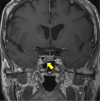Neurofibromatosis Type 1 with Concurrent Multiple Endocrine Disorders: Adenomatous Goiter, Primary Hyperparathyroidism, and Acromegaly
- PMID: 34334593
- PMCID: PMC8381186
- DOI: 10.2169/internalmedicine.4981-20
Neurofibromatosis Type 1 with Concurrent Multiple Endocrine Disorders: Adenomatous Goiter, Primary Hyperparathyroidism, and Acromegaly
Abstract
We encountered a 70-year-old Japanese woman with neurofibromatosis type 1 (NF1) who had a history of pheochromocytoma and concurrently developed adenomatous goiter, primary hyperparathyroidism, and acromegaly. The patient had a somatotroph adenoma of the adenohypophysis that predisposed her to multinodular goiter. Three parathyroid tumors were detected by cervical ultrasonography and cervicothoracic computed tomography. Genetic analyses did not reveal genetic alterations (e.g. loss-of-function mutation) in the causative genes of endocrine tumors, including MEN1, RET, VHL, CDKN1B, and CDKN2C. The NF1 gene could not be analyzed genetically due to the patient's refusal. The pathophysiologic mechanisms of endocrinopathy concurrence in NF1 remain to be elucidated.
Keywords: acromegaly; adenomatous goiter; neurofibromatosis type 1; primary hyperparathyroidism.
Conflict of interest statement
Figures






Similar articles
-
Acromegaly caused by a somatotroph adenoma in patient with neurofibromatosis type 1.Endocr J. 2019 Oct 28;66(10):853-857. doi: 10.1507/endocrj.EJ19-0035. Epub 2019 Jun 12. Endocr J. 2019. PMID: 31189769
-
Acromegaly and late-onset primary hyperparathyroidism in a female with a rare MEN1 gene variant of yet undetermined clinical significance (p.Val167Ala).Endokrynol Pol. 2020;71(6):579-580. doi: 10.5603/EP.a2020.0063. Epub 2020 Oct 30. Endokrynol Pol. 2020. PMID: 33125695
-
[Pheochromocytoma associated with primary hyperparathyroidism and type 1 neurofibromatosis].Khirurgiia (Mosk). 2023;(7):120-127. doi: 10.17116/hirurgia2023071120. Khirurgiia (Mosk). 2023. PMID: 37379415 Russian.
-
Isolated Absent Thelarche in a Patient With Neurofibromatosis Type 1 and Acromegaly.Obstet Gynecol. 2018 Jan;131(1):96-99. doi: 10.1097/AOG.0000000000002389. Obstet Gynecol. 2018. PMID: 29215515 Free PMC article. Review.
-
Pheochromocytoma in von Hippel-Lindau disease and neurofibromatosis type 1.Fam Cancer. 2005;4(1):13-6. doi: 10.1007/s10689-004-6128-y. Fam Cancer. 2005. PMID: 15883705 Review.
Cited by
-
A novel nomogram for predicting osteoporosis with low back pain among the patients in Wenshan Zhuang and Miao Autonomous Prefecture of China.Front Endocrinol (Lausanne). 2025 Jun 5;16:1535163. doi: 10.3389/fendo.2025.1535163. eCollection 2025. Front Endocrinol (Lausanne). 2025. PMID: 40538801 Free PMC article.
-
Association of pituitary neuroendocrine tumors and neurofibromatosis type 1: assessing causation versus coincidence. Case report.Front Endocrinol (Lausanne). 2025 Feb 4;16:1483305. doi: 10.3389/fendo.2025.1483305. eCollection 2025. Front Endocrinol (Lausanne). 2025. PMID: 39968302 Free PMC article.
-
A Comprehensive Target Panel Allows to Extend the Genetic Spectrum of Neuroendocrine Tumors.Neuroendocrinology. 2025;115(5):381-401. doi: 10.1159/000542223. Epub 2024 Nov 13. Neuroendocrinology. 2025. PMID: 39536727 Free PMC article.
-
Unlocking the Genetic Secrets of Acromegaly: Exploring the Role of Genetics in a Rare Disorder.Curr Issues Mol Biol. 2024 Aug 20;46(8):9093-9121. doi: 10.3390/cimb46080538. Curr Issues Mol Biol. 2024. PMID: 39194755 Free PMC article. Review.
-
Parathyroid carcinoma and pheochromocytoma in a patient with neurofibromatosis type 1: a rare association.Endocrinol Diabetes Metab Case Rep. 2025 Feb 10;2025(1):e240077. doi: 10.1530/EDM-24-0077. Print 2025 Jan 1. Endocrinol Diabetes Metab Case Rep. 2025. PMID: 39932063 Free PMC article.
References
-
- Bizzarri C, Bottaro G. Endocrine implications of neurofibromatosis 1 in childhood. Horm Res Paediatr 83: 232-241, 2015. - PubMed
-
- National Institutes of Health Consensus Development Conference Statement. Neurofibromatosis. Arch Neurol Chicago 45: 575-578, 1988. - PubMed
-
- Jett K, Friedman JM. Clinical and genetic aspects of neurofibromatosis 1. Genet Med 12: 1-12, 2010. - PubMed
-
- Cimino PJ, Gutmann DH. Neurofibromatosis type 1. Handb Clin Neurol 148: 799-811, 2018. - PubMed
-
- Yoshida Y, Kuramochi A, Oota Y, et al. . Clinical guidelines for neurofibromatosis type 1 (Recklinghausen disease) 2018. Nihon Hifukagakkai Zasshi 128: 17-34, 2018(in Japanese).
Publication types
MeSH terms
LinkOut - more resources
Full Text Sources
Medical
Research Materials
Miscellaneous

